Thomas Hearns and the origin of the ‘Hitman Cover’
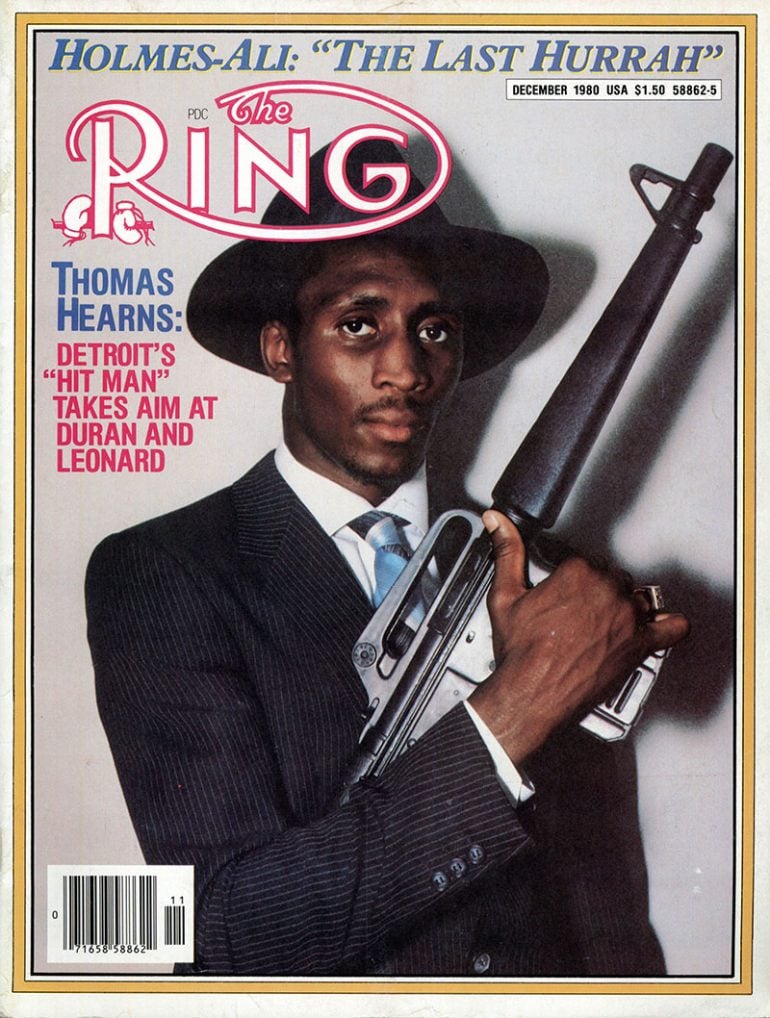
In honor of the legendary Thomas Hearns’ birthday, we offer this gem from former Ring Magazine Editor-in-Chief and Chairman of the New York State Athletic Commission Randy Gordon. The feature originally appeared in the February 2022 issue of The Ring Magazine, our 100th anniversary special edition, which you can find in our store.
LETTERS FROM THE EDITORS
The Hitman Cover
FORMER RING EDITOR RANDY GORDON RECOUNTS THE STORY BEHIND ONE OF THE PUBLICATION’S MOST ICONIC IMAGES
You’re a boxing fan. You’re a reader of The Ring. No matter what your age, you have most likely seen or are familiar with the December 1980 issue of The Ring. That’s the one with Thomas Hearns on the cover, dressed in a black, pinstriped suit, wearing a black fedora and holding a black machine gun. It is known as The Ring’s “Hitman Cover.”
Forty years after that magazine hit the stands, it remains one of the most talked-about covers of The Ring in its 100-year history.
I more than remember that cover. I created it! I was there for the photo shoot with Hearns. What a photo shoot it was! We were actually one click of the shutter away from not getting the shot. It’s true. That fabulous cover almost never happened. Why? Because Hearns was uncooperative. Hysterically – as in laughing hysterically – uncooperative. It was, without question, the funniest photo shoot I have ever seen or been a part of.
The making of the cover began on a warm day in New York City in mid-September 1980. It was time for The Ring’s publisher, Bert Randolph Sugar, and I to discuss the next issue of the magazine. Who would be on the cover of our magazine? Who would we assign to write the cover story? What would the angle be? What stories would fill our 84 pages? Yes, it was time for the Sugar/Gordon monthly editorial meeting.
Sugar and I took our editorial meetings 200 yards up 31st Street, across Broadway to an Irish pub called O’Reilly’s.
With most other magazines, editorial meetings are done in a boardroom cleaner than an operating room. In the old building that housed our offices at 120 W. 31st Street, no such room existed. Even if it did, a room like that would have been way too sterile for either Bert or me. Also, having an editorial meeting at The Ring in Sugar’s office wouldn’t work either, as our office phones (there were no cell phones around in 1980) rang constantly. So, Sugar and I took our editorial meetings 200 yards up 31st Street, across Broadway to an Irish pub called O’Reilly’s. It was there that just about every issue of The Ring between October 1979 and December 1984 was conceived.
As Sugar and I walked towards O’Reilly’s, he turned to me and said, “How about we go with [Muhammad] Ali on the cover.”
I looked at him and winced, saying, “Bert, we just had Ali on the cover two issues ago, along with Larry Holmes, remember? On top of that, we are going to Vegas in less than three weeks to see Ali face Larry Holmes in what we both believe will most likely be Ali’s final fight. How can we put him on the next cover?”
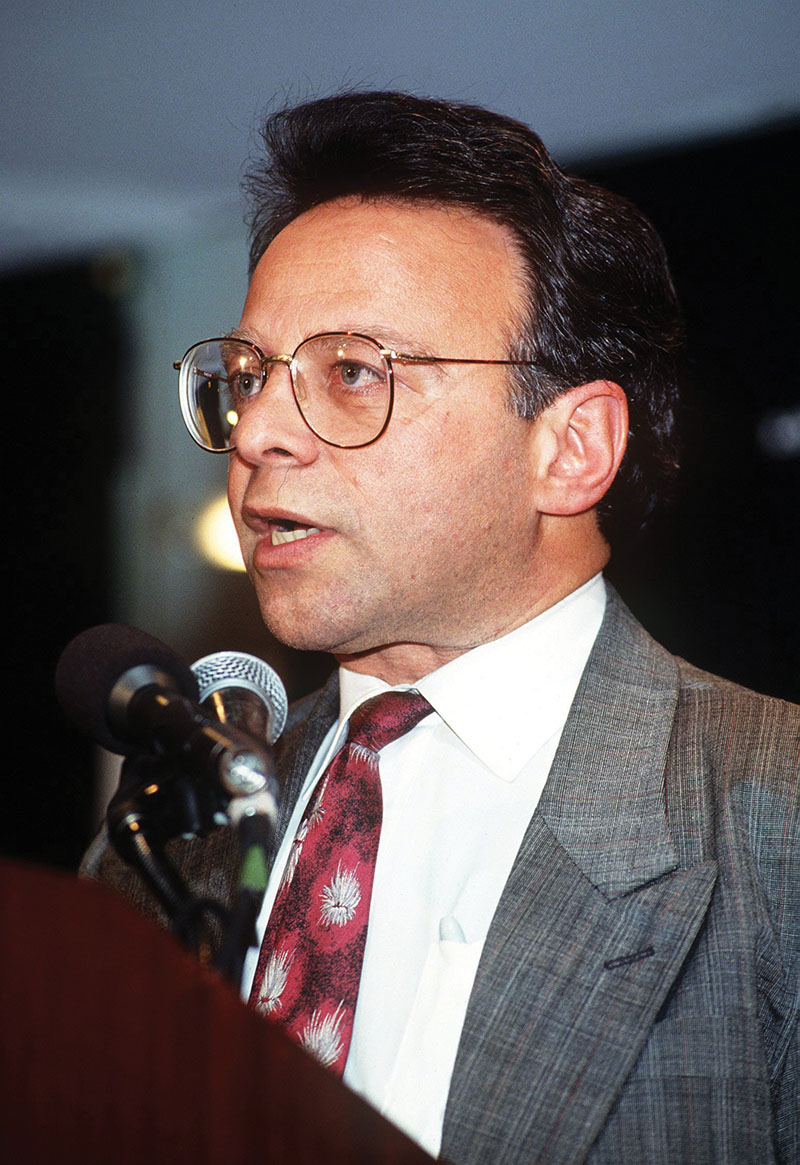
Randy Gordon as chairman of the New York State Athletic Commission, a position he held after his tenure at The Ring. (Photo by Lonnie Major/ALLSPORT)
Bert nodded as he walked.
“Let’s think more at O’Reilly’s. I need a couple of drinks and a good ’gar (Sugar always called a cigar a ’gar) to put me in the mood.”
When we arrived, the maître d’ said, “Hello, Mr. Sugar. Hello, Mr. Gordon. Your table awaits you.”
We always sat at the same table. O’Reilly’s was our home away from home during the work week. The manager, the maître d’, the bartender, the waiters, waitresses and even the busboys knew us.
When we sat down, Bert immediately took out a ’gar and lit it up. In 1980, there were no anti-smoking mandates in restaurants. Smoking in restaurants, our office, on planes or anywhere else meant Bert would rarely be without a ’gar – lit or unlit.
He was brought a Scotch on the rocks. I was brought a Guinness.
The December issue was underway.
It took us less than five minutes to choose Hearns as the next cover subject of The Ring. Then came the discussion of what kind of photo we should use. Would it be a headshot or a pose? Do we fly out to Detroit and sit him in a fancy sports car? Do we put him in front of a backdrop of Detroit, perhaps with a realistic rubber cobra draped over his shoulders? After all, he was “The Motor City Cobra.” Then, this is how the conversation went:
RANDY: “Wait! Why don’t we have Hearns dress in a black, pinstriped suit, holding a snub-nose pistol? After all, he is also the ‘Hitman.’”
Sugar’s eyes opened wide.
BERT: “Yes! Yes! But not a handgun. Let’s make it a machine gun.”
BERT and RANDY: “A TOMMY GUN!” we yelled in unison. The lunch crowd all stared at us.
We raised our arms and slapped each others’ hands.
Some people wait politely for their server to be free. Bert didn’t wait. He yelled to our server, who was across the room, “MICHAEL, GET US ANOTHER ROUND!” Sugar paused for perhaps a second, then added – loudly – “AND BUY EVERYBODY ELSE IN THE HOUSE A DRINK ON US!” The room cheered.
“Nice going,” Sugar said to me. “I see this cover as being a classic.”
I didn’t react. My mind was still churning, envisioning our next cover. Sugar could see I was in deep thought.
“What are you thinking? Share it with me,” he said. I smiled.
“Not only will Hearns be in a pinstripe suit with a Tommy gun,” I said, “he will wear one more thing.”
Sugar squinted in curiosity.
“What’s that?” he asked.
I didn’t say a thing. I just shifted my gaze from his eyes to the top of his head. He got it immediately.
“One of my fedoras!” he responded.
“You got that right!” I said. He lifted his Scotch and raised his glass.
“To the ‘Hitman’ cover,” he toasted.
I raised my glass and repeated his words.
“To the ‘Hitman’ cover,” I said.
Suddenly, I realized something very important. I asked Sugar, “Where are we going to get a Tommy gun?”
He gave me a blank stare.
“That’s your problem!” he said. “Find one!”
After another round of drinks and a couple of burgers, we were out of O’Reilly’s and on our way back to The Ring.
Back in the office, I picked up the phone and called Emanuel Steward, Hearns’ manager and trainer. I told him of our cover idea for Hearns and he loved it.
“I’m coming into New York for a meeting with HBO next week,” he told me. “We’ll be on an early flight. We’ll have time to play with. How about we come up to your office? Do you have a photo room?”
“We certainly do!” I told him. We set the day.
When I told him I’d need to rent a pinstriped suit for Hearns, Steward said, “Hold off on that. I think he has one. If he does, I’ll have him bring it along.” Within the hour, Steward called me back, confirming Hearns’ ownership of such a suit. They couldn’t have made it any easier for us.
***
Thomas Hearns was the new WBA welterweight champion. He won the title in devastating fashion around six weeks earlier, knocking out reigning titlist Pipino Cuevas in the second round. Since turning professional in November 1977, Hearns had powered his way to a 28-0 record, including 26 knockouts. The power Hearns displayed as a professional was a far cry from the fast-handed boxer he was in the amateurs, where he knocked out no more than one dozen opponents in amassing a 155-8 record.
Now, as a world champion, he’d be on the cover of The Ring for the first of many times. Finding a Tommy gun was imperative.
Over the next few days, I called every gun store in Manhattan, and many in Connecticut and New Jersey. They had handguns, hunting rifles and target rifles. They had BB guns, pellet guns and shotguns. But nobody had a Tommy gun. Where was the internet when I needed it?
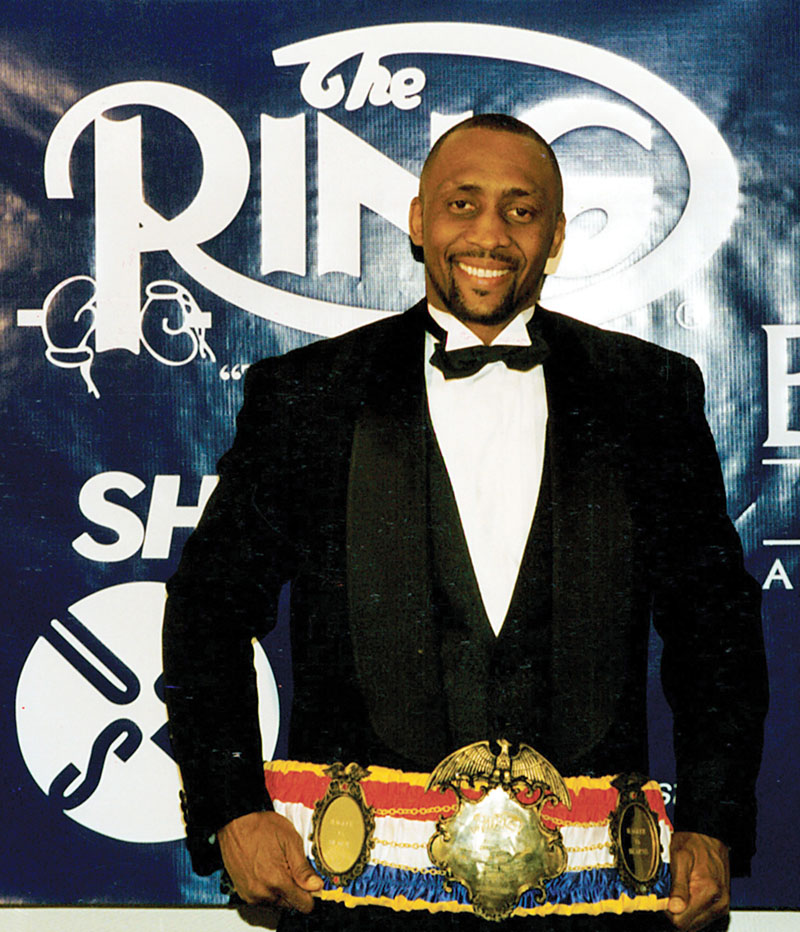
Hearns in 1997 with the Ring 154-pound title belt he won by defeating Wilfred Benitez in 1982.(Photo by The Ring Magazine via Getty Images)
Then, three days before the arrival of Hearns, I found a Tommy gun in the most unlikely of places – but we’ll get to that soon.
When Hearns and Steward emerged from the rickety, painfully slow elevator on the fifth floor, they ran into Bert, who was walking out of his office, which had previously been occupied by editors-in-chief Nat Loubet and Nat Fleischer before him. It was an office I would occupy a few years later.
The sound in the office went from quiet to intense the moment Hearns and Steward ran into Bert. It was as if they were longtime acquaintances. In fact, this was only the second time they had met each other. The first was seven months earlier, when Sugar and I went to Las Vegas to cover the Larry Holmes-Lorenzo Zanon world heavyweight title fight, as well as undefeated 122-pound champion Wilfredo Gomez’s title defense against Ruben Valdes. Hearns, then 24-0, was on the undercard against Fighting Jim Richards, who went down fighting in Round 3.
For me, it was the second time I had been in the company of the Kronk stars. The first time was in April 1979, when I traveled from NYC to Philadelphia to cover a J. Russell Peltz card at the Spectrum, which featured up-and-coming stars Jeff Chandler, Curtis Parker, Jerry “The Bull” Martin, Randall “Tex” Cobb, Kevin Howard and Teddy Mann.
We talked for a few minutes, but Steward and Hearns were pressed for time. It was 10:30 and they had to be in HBO’s offices 15 blocks uptown in a little over an hour.
Our staff photographer, Jack Goodman, had his camera, the backdrop and the lights ready. All Hearns had to do was change. As he headed into the bathroom to do so, I handed him the Tommy gun. He laughed and took it into the men’s room.
When he stepped out of the bathroom, Bert handed him one of his black fedoras. Tommy placed it on his head, then went back into the bathroom to check himself out in the mirror. His laughter could be heard throughout our office. Our stockboys came running out to see what was so funny.
Upon walking out of the men’s room this time, Hearns pulled the trigger of the Tommy gun, shooting into boxes piled on the floor.
“TOMMY, THOSE ARE PHOTOS, YOU’LL RUIN THEM! screamed Bert. Tommy whirled around and said, “What else can I shoot?”
“Later,” I said. “We’ve gotta’ get you going.”
He followed us into the photo room, where Goodman took many of his cover shots.
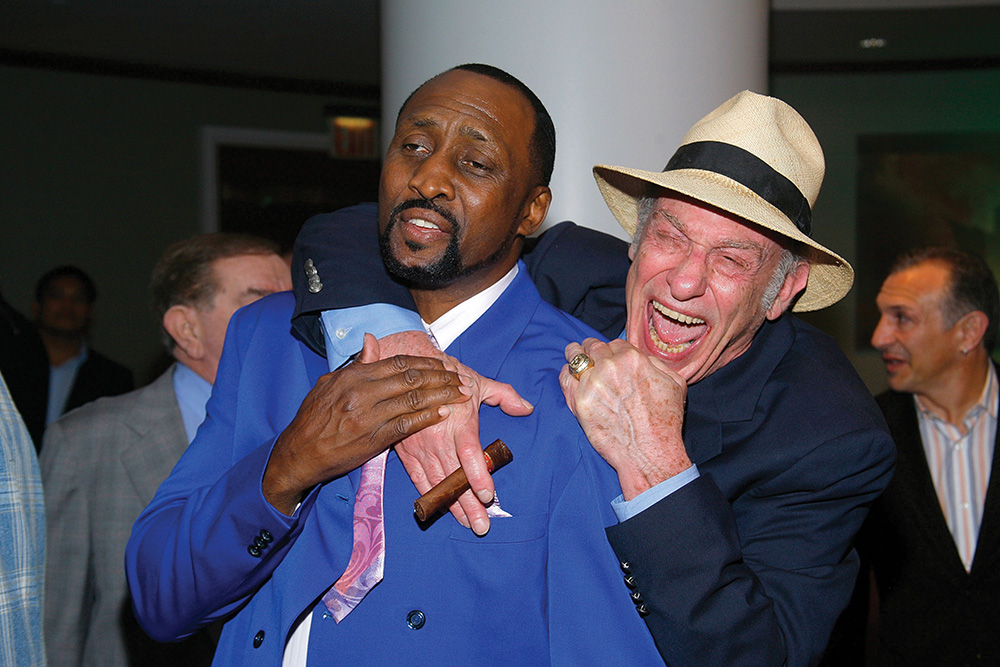
Colorful characters: Bert Sugar and five-weight world champion Thomas Hearns in 2010. (Photo by Andy Kropa/Getty Images)
In 1980, we had cameras that used something called film. The film had around 40 shots per roll. After using each roll, the photographer had to stop and reload.
I told Hearns how we wanted him to stand and how we wanted him to look. We needed the gun across his chest and we needed him to look mean … dangerous … threatening. He couldn’t do it.
As Goodman held down the button on his motor-drive camera, ripping off photo after photo, Hearns joked around. He continually pointed the gun at me and Steward, who were standing next to each other, perhaps a foot away on Hearns’ right.
Hearns needed to stop laughing, give us one mean-looking shot and get to HBO. We needed a photo. Just one.
“You wanna get it?” he asked me.
“You?” he said, in a tough voice, to Steward.
He laughed as Goodman resumed taking photos and as I screamed “MEAN, TOMMY, MEAN!”
On a few occasions, he pulled the trigger, narrowly missing our copy girl, Liz, and our secretaries, Jenny and Nancy.
He laughed hysterically every time he pulled the trigger. One time, he shot me in the arm. He shot Steward in both legs. He shot Bert in the stomach when our publisher approached him, begging him to stop laughing. At one point, Hearns was actually choking from laughing so hard.
But time was running out. Hearns needed to stop laughing, give us one mean-looking shot and get to HBO. We needed a photo. Just one. All we had were photos of Hearns laughing and smiling.
Finally, Goodman was on his last roll of film. I begged Hearns to look mean, even giving him playful slaps on his right shoulder.
“MEAN, TOMMY, MEAN! PLEASE! JUST ONCE!”
Then came a yell from Goodman.
“I GOT IT! I’M PRETTY SURE I GOT IT!”
Hearns then put the Tommy gun down, put on a Ring T-shirt and took photos with Liz, Jenny and Nancy. He then changed into business attire, and he, along with Steward, left for their scheduled appointment with HBO.
Yes, Goodman got the photo we were looking for. Of the 400 photos he took, this was his final shot. It has become an iconic classic and hangs, autographed and framed, in many offices and gyms around the world.
The photo was sinister-looking. Several ad agencies dropped Hearns immediately from their roster of clients. The mayor of Detroit at that time was Coleman Young. He said to Hearns’ publicist, Jackie Kallen, “Why would you (Hearns’ management) do that with him? It evokes memories of 1930s Chicago. It’s awful!”
Kallen, still very active in boxing, agrees with Coleman but understands what we were doing.
“We tried our best to downplay the cover,” explained Kallen, “but there was no way to downplay it. That cover was the talk of, not just boxing fans, but everybody in Detroit, whether or not they were boxing fans. We just wanted that cover to go away.”
How does Ms. Kallen feel today?
“It’s a work of art. Thomas Hearns was the ‘Hitman,’ but only in a boxing sense. You and Bert brought that out artistically in the most perfect way possible. I have a framed copy hanging in my office.”
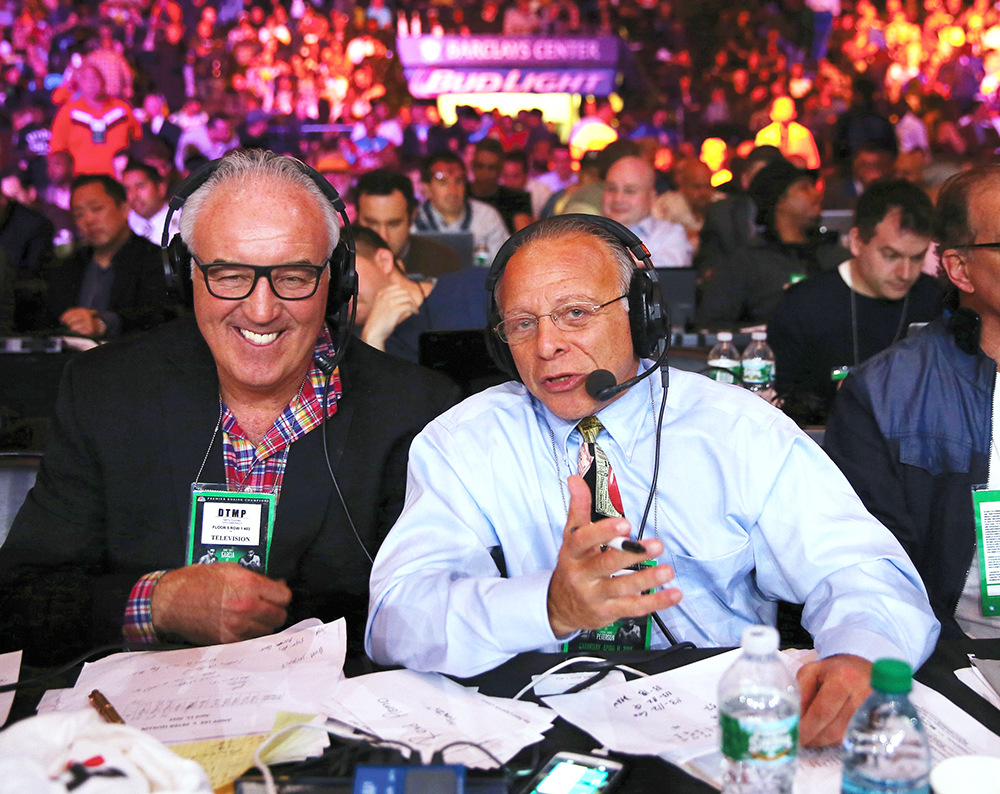
Gordon at ringside with former heavyweight star Gerry Cooney. (Photo by Elsa/Getty Images)
As for being shot by Hearns, I really didn’t mind it. Neither did Emanuel and neither did Bert.
Did I just write “didn’t mind”?
That’s right. You see, the Tommy gun I was looking for but couldn’t find in three states was right in my home on Long Island. It was a water pistol. It belonged to my 3-year-old daughter, Ali. I had bought two of them earlier that summer so the two of us could have water-gun battles in the backyard.
It is hard to believe that the frightening, intimidating Tommy gun that is part of one of The Ring’s most popular and unforgettable covers was nothing more than my daughter’s water pistol.
For the first time in the 41 years since that cover came out, I’d like to personally and publically thank Thomas Hearns and Emanuel Steward for making it happen, and for being great sports about it.
Thomas, you may have lost endorsements because of that cover, but you gave boxing fans something to talk about and cherish for the ages.
Thank you, “Hitman.”
***
You can email Randy Gordon at [email protected]
READ THE LATEST ISSUE OF THE RING FOR FREE VIA THE NEW APP NOW. SUBSCRIBE NOW TO ACCESS MORE THAN 10 YEARS OF BACK ISSUES.
















